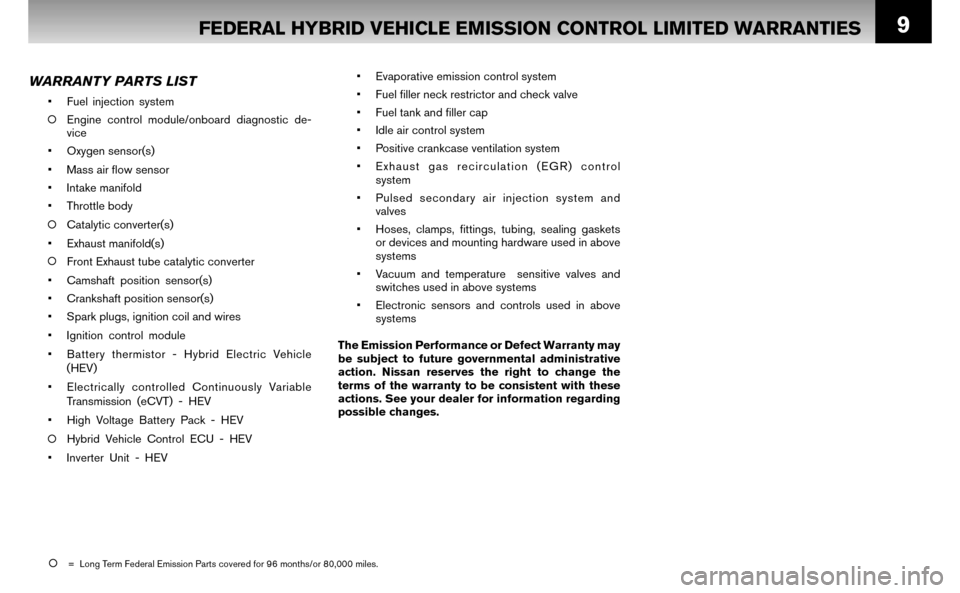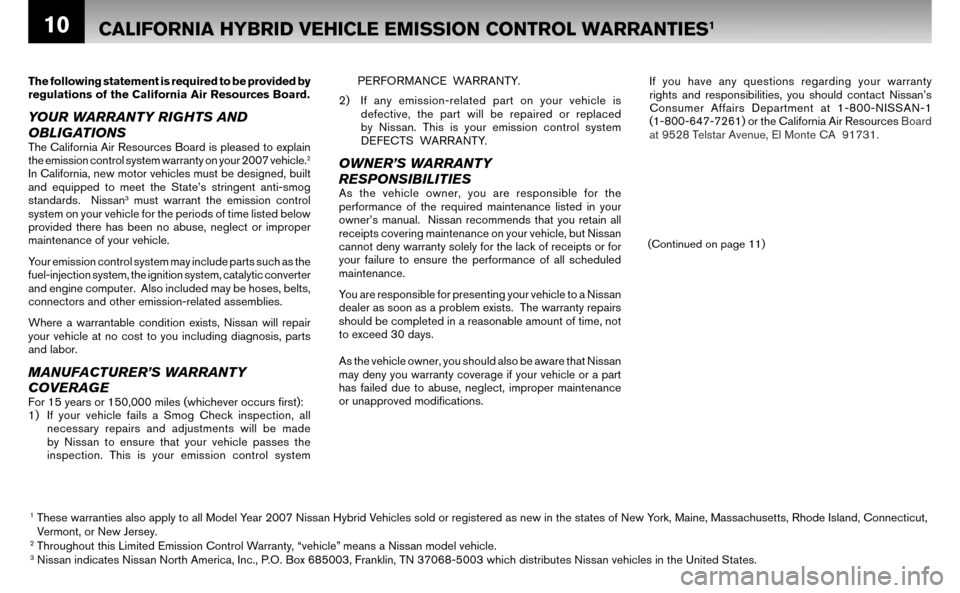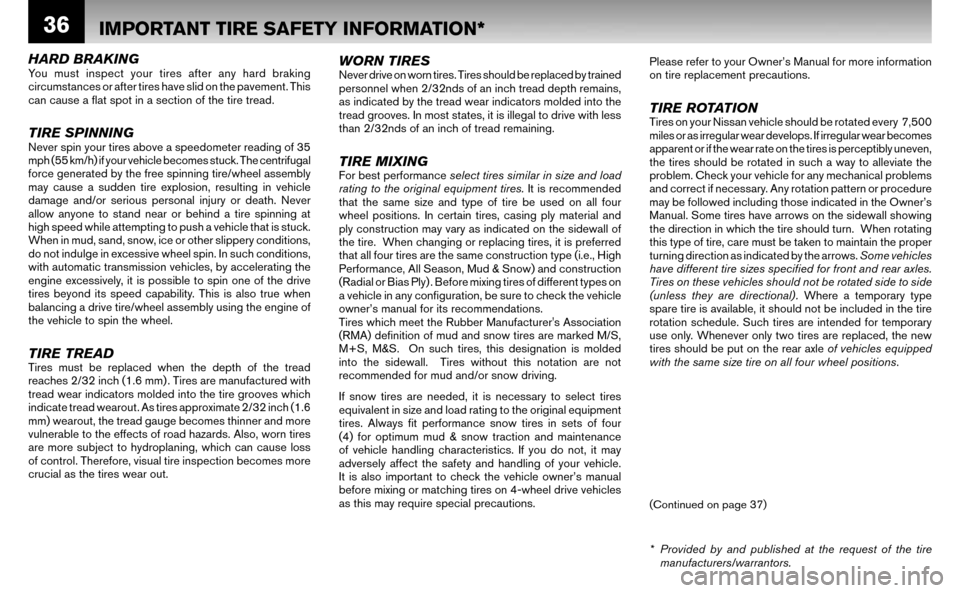check engine NISSAN ALTIMA HYBRID 2007 L32A / 4.G Warranty Booklet
[x] Cancel search | Manufacturer: NISSAN, Model Year: 2007, Model line: ALTIMA HYBRID, Model: NISSAN ALTIMA HYBRID 2007 L32A / 4.GPages: 54, PDF Size: 1.71 MB
Page 13 of 54

9FEDERAL HYBRID VEHICLE EMISSION CONTROL LIMITED WARRANTIES
• Evaporative emission control system
• Fuel fi ller neck restrictor and check valve
• Fuel tank and fi ller cap
• Idle air control system
• Positive crankcase ventilation system
• Exhaust gas recirculation (EGR) control system
• Pulsed secondary air injection system and valves
• Hoses, clamps, fi ttings, tubing, sealing gaskets or devices and mounting hardware used in above
systems
• Vacuum and temperature sensitive valves and switches used in above systems
• Electronic sensors and controls used in above systems
The Emission Performance or Defect Warranty may
be subject to future governmental administrative
action. Nissan reserves the right to change the
terms of the warranty to be consistent with these
actions. See your dealer for information regarding
possible changes.
= Long Term Federal Emission Parts covered for 96 months/or 80,000 miles.
WARRANTY PARTS LIST
• Fuel injection system
Engine control module/onboard diagnostic de- vice
• Oxygen sensor(s)
• Mass air fl ow sensor
• Intake manifold
• Throttle body
Catalytic converter(s)
• Exhaust manifold(s)
• Front Exhaust tube catalytic converter
• Camshaft position sensor(s)
• Crankshaft position sensor(s)
• Spark plugs, ignition coil and wires
• Ignition control module
• Battery thermistor - Hybrid Electric Vehicle (HEV)
• Electrically controlled Continuously Variable Transmission (eCVT) - HEV
• High Voltage Battery Pack - HEV
• Hybrid Vehicle Control ECU - HEV
• Inverter Unit - HEV
Page 14 of 54

10
Ts
f
n
s
VThe following statement is required to be provided by
regulations of the California Air Resources Board.
YOUR WARRANTY RIGHTS AND
OBLIGATIONS
The California Air Resources Board is pleased to explain
the emission control system warranty on your 2007 vehicle.2
In California, new motor vehicles must be designed, built
and equipped to meet the State’s stringent anti-smog
standards. Nissan
3 must warrant the emission control
system on your vehicle for the periods of time listed below
provided there has been no abuse, neglect or improper
maintenance of your vehicle.
Your emission control system may include parts such as the
fuel-injection system, the ignition system, catalytic converter
and engine computer. Also included may be hoses, belts,
connectors and other emission-related assemblies.
Where a warrantable condition exists, Nissan will repair
your vehicle at no cost to you including diagnosis, parts
and labor.
MANUFACTURER’S WARRANTY
COVERAGE
For 15 years or 150,000 miles (whichever occurs fi rst):
1) If your vehicle fails a Smog Check inspection, all necessary repairs and adjustments will be made
by Nissan to ensure that your vehicle passes the
inspection. This is your emission control system
CALIFORNIA HYBRID VEHICLE EMISSION CONTROL WARRANTIES1
1 These warranties also apply to all Model Year 2007 Nissan Hybrid Vehicles sold or registered as new in the states of New York, Maine, Massachusetts, Rhode Island, Connecticut,
Vermont, or New Jersey.
2 Throughout this Limited Emission Control Warranty, “vehicle” means a Nissan model vehicle.3 Nissan indicates Nissan North America, Inc., P.O. Box 685003, Franklin, TN 37068-5003 which distributes Nissan vehicles in the United States.
(Continued on page 11)
If you have any questions regarding your warranty
rights and responsibilities, you should contact Nissan’s
Consumer Affairs Department at 1-800-NISSAN-1
(1-800-647-7261) or the California Air Resources Board
at 9528 Telstar Avenue, El Monte CA 91731.
PERFORMANCE WARRANTY.
2) If any emission-related part on your vehicle is defective, the part will be repaired or replaced
by Nissan. This is your emission control system
DEFECTS WARRANTY.
OWNER’S WARRANTY
RESPONSIBILITIES
As the vehicle owner, you are responsible for the
performance of the required maintenance listed in your
owner’s manual. Nissan recommends that you retain all
receipts covering maintenance on your vehicle, but Nissan
cannot deny warranty solely for the lack of receipts or for
your failure to ensure the performance of all scheduled
maintenance.
You are responsible for presenting your vehicle to a Nissan
dealer as soon as a problem exists. The warranty repairs
should be completed in a reasonable amount of time, not
to exceed 30 days.
As the vehicle owner, you should also be aware that Nissan
may deny you warranty coverage if your vehicle or a part
has failed due to abuse, neglect, improper maintenance
or unapproved modifi cations.
Page 40 of 54

36
HARD BRAKINGYou must inspect your tires after any hard braking
circumstances or after tires have slid on the pavement. This
can cause a fl at spot in a section of the tire tread.
TIRE SPINNINGNever spin your tires above a speedometer reading of 35
mph (55 km/h) if your vehicle becomes stuck. The centrifugal
force generated by the free spinning tire/wheel assembly
may cause a sudden tire explosion, resulting in vehicle
damage and/or serious personal injury or death. Never
allow anyone to stand near or behind a tire spinning at
high speed while attempting to push a vehicle that is stuck.
When in mud, sand, snow, ice or other slippery conditions,
do not indulge in excessive wheel spin. In such conditions,
with automatic transmission vehicles, by accelerating the
engine excessively, it is possible to spin one of the drive
tires beyond its speed capability. This is also true when
balancing a drive tire/wheel assembly using the engine of
the vehicle to spin the wheel.
TIRE TREADTires must be replaced when the depth of the tread
reaches 2/32 inch (1.6 mm) . Tires are manufactured with
tread wear indicators molded into the tire grooves which
indicate tread wearout. As tires approximate 2/32 inch (1.6
mm) wearout, the tread gauge becomes thinner and more
vulnerable to the effects of road hazards. Also, worn tires
are more subject to hydroplaning, which can cause loss
of control. Therefore, visual tire inspection becomes more
crucial as the tires wear out.
WORN TIRESNever drive on worn tires. Tires should be replaced by trained
personnel when 2/32nds of an inch tread depth remains,
as indicated by the tread wear indicators molded into the
tread grooves. In most states, it is illegal to drive with less
than 2/32nds of an inch of tread remaining.
TIRE MIXINGFor best performance select tires similar in size and load
rating to the original equipment tires. It is recommended
that the same size and type of tire be used on all four
wheel positions. In certain tires, casing ply material and
ply construction may vary as indicated on the sidewall of
the tire. When changing or replacing tires, it is preferred
that all four tires are the same construction type (i.e., High
Performance, All Season, Mud & Snow) and construction
(Radial or Bias Ply) . Before mixing tires of different types on
a vehicle in any confi guration, be sure to check the vehicle
owner’s manual for its recommendations.
Tires which meet the Rubber Manufacturer's Association
(RMA) defi nition of mud and snow tires are marked M/S,
M+S, M&S. On such tires, this designation is molded
into the sidewall. Tires without this notation are not
recommended for mud and/or snow driving.
If snow tires are needed, it is necessary to select tires
equivalent in size and load rating to the original equipment
tires. Always fi t performance snow tires in sets of four
(4) for optimum mud & snow traction and maintenance
of vehicle handling characteristics. If you do not, it may
adversely affect the safety and handling of your vehicle.
It is also important to check the vehicle owner’s manual
before mixing or matching tires on 4-wheel drive vehicles
as this may require special precautions. Please refer to your Owner’s Manual for more information
on tire replacement precautions.
TIRE ROTATIONTires on your Nissan vehicle should be rotated every 7,500
miles or as irregular wear develops. If irregular wear becomes
apparent or if the wear rate on the tires is perceptibly uneven,
the tires should be rotated in such a way to alleviate the
problem. Check your vehicle for any mechanical problems
and correct if necessary. Any rotation pattern or procedure
may be followed including those indicated in the Owner’s
Manual. Some tires have arrows on the sidewall showing
the direction in which the tire should turn. When rotating
this type of tire, care must be taken to maintain the proper
turning direction as indicated by the arrows.
Some vehicles
have different tire sizes specifi ed for front and rear axles.
Tires on these vehicles should not be rotated side to side
(unless they are directional) . Where a temporary type
spare tire is available, it should not be included in the tire
rotation schedule. Such tires are intended for temporary
use only. Whenever only two tires are replaced, the new
tires should be put on the rear axle of vehicles equipped
with the same size tire on all four wheel positions .
* Provided by and published at the request of the tire manufacturers/warrantors.
IMPORTANT TIRE SAFETY INFORMATION*
(Continued on page 37)